
PEEK valve seats vs PTFE valve seats
In the current market, PTFE vs PEEK has been holding a very high position of the material value and material performance compared to many other plastics. Currently, both PTFE and PEEK have specific applications corresponding to their properties, but there are still concerns about which one is better for certain applications. To clarify this, below is an analysis of the concepts, technical data, properties and applications of PEEK vs PTFE to help you understand a more realistic comparison of these two materials.
1. What is PEEK?
PEEK, also known as Polyetheretherketone, belongs to the group of high performance semi-crystalline thermoplastics. This is a colorless plastic widely used in many technical applications. PEEK has a modulus of 3.6 GPa and possesses a tensile strength of about 90 - 100 MPa. PEEK melts at about 343 °C (662 °F) and has a glass transition temperature of about 143 °C (289 °F). Some types have useful operating temperatures up to 250 °C (482 °F). From here it can be seen that PEEK plastic has a very wide temperature range. Several methods such as injection molding, extrusion or compression molding are often used to shape PEEK plastic. The crystallinity of PEEK and their mechanical properties can be influenced by processing conditions during molding. In terms of properties, PEEK plastic has high mechanical and chemical durability. Evidence can include its ability to be sustainable in non-halogenated environments, strong acids as well as some halogenated compounds and aliphatic hydrocarbons at high temperatures. Additionally, it can completely dissolve sulfuric acid at room temperature. Besides, PEEK plastic also exhibits light weight, flexibility, and low moisture absorption.
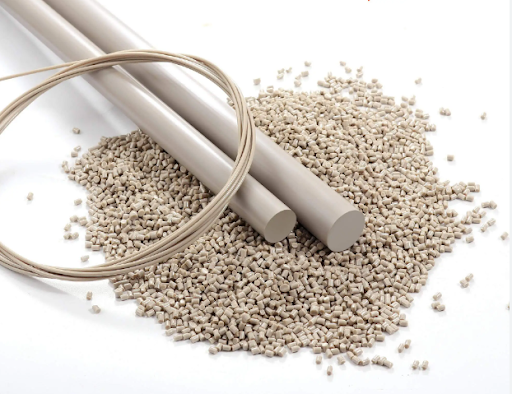
PEEK plastic has a chemical durability
Thanks to the properties just mentioned, PEEK plastic is often used to produce piston parts, machinery valves, insulated cables, pumps, etc. PEEK plastic is one of the few plastics that is compatible with many applications. extremely high vacuum. The aerospace, automotive and chemical processing industries have also become fond of PEEK plastic thanks to this property.
Read more: PEEK plastic: Definition and Application
2. What is PTFE?
Just like PEEK, PTFE plastic is also a thermoplastic. We may know PTFE by other names such as PolyTetraFluoroEthylene, teflon, fluoropolymer. This is a polymerization of tetrafluoroethylene formed by a chemical reaction that combines particles into large, repeating molecular groups. Tetrafluoroethylene (C2F4), is made by heating chlorodifluoromethane (CHClF2) between 600–700 °C (1,100–1,300 °F). Chlorodifluoromethane is obtained in turn by reacting hydrogen fluoride (HF) with chloroform (CHCl3 ). Tetrafluoroethylene monomers (small, single-unit molecules) are suspended or emulsified in water and then polymerized (bonded into giant, multi-unit molecules) under high pressure in the presence of free radical initiator. The polymer consists of a chain of carbon atoms with two fluorine atoms bonded to each carbon: where the carbon chain is surrounded by fluorine atoms that act as a protective shell. PTFE plastic has quite impressive heat resistance with a very high melting point of up to about 327 ° C. At temperatures below 260°C, PTFE can be used continuously without deterioration.

PTFE is very durable
Some outstanding properties of PTFE include resistance to most corrosive substances, water resistance, extremely low friction coefficient, non-stickiness, and high flexibility. For PTFE, degradation in air by radiation attacks begins to show at a dose of 0.02 Mrad. Applications for manufacturing heat-resistant machinery, machinery in harsh environments, chemical containers and also used in some cooking utensils thanks to its non-stick properties.
Read more: All You Need to Know About PTFE
3. Technical data comparison: PEEK vs PTFE
3.1 Technical data of PEEK
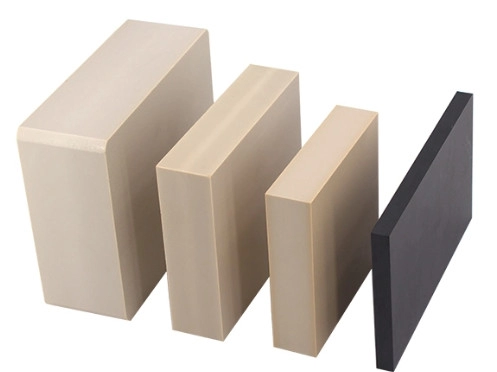
PEEK plastic bars
- Tensile Strength: 90-100 Mpa
-
Elongation: 30-40%
-
Compressive Strength: 140 Mpa
-
Flexural Modulus: 3900 Mpa
-
Coefficient of Friction: 0.35-0.45
-
Temperature resistance: Up to 250°C
-
Dielectric strength: 50 Kv/mm
-
Chemical resistance: Affected by Sulfuric acid
-
Coefficient of linear thermal expansion: 5 x 10-5/K
-
Price: Very expensive
3.2 Technical data of PTFE

PTFE plastic bars
- Tensile Strength: 25-35 Mpa
-
Elongation: 350-400%
-
Compressive Strength: 30-40 Mpa
-
Flexural Modulus: 495 Mpa
-
Coefficient of Friction: 0.03-0.05
-
Temperature resistance: Up to 250°C
-
Dielectric strength: 50-150 Kv/mm
-
Chemical resistance: Virtually inert
-
Coefficient of linear thermal expansion: 14 x 10-5/K
-
Price: Moderately expensive
4. Properties comparison: PEEK vs PTFE
4.1 PEEK material possesses:
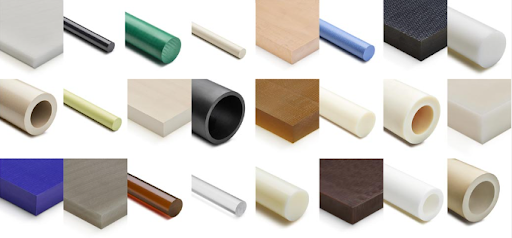
PEEK plastic has high heat resistance, flexibility, durability
- Recyclability: PEEK plastic is known for its almost non-toxicity, so it is very suitable for products that are friendly to human health and highly recyclable.
-
Durability: PEEK plastic has high heat resistance, flexibility, durability and abrasion resistance against long-term mechanical and chemical impacts.
- Chemical resistance: PEEK plastic has almost no chemical reactions when exposed to chemicals. Besides, PEEK plastic also has hydrolysis resistance.
- Low moisture absorption: PEEK is naturally hydrophobic; it does not absorb moisture.
In addition, PEEK plastic also exhibits advantages such as resistance to heat radiation, less flammability, less toxic gases, and less aging due to heat.
4.2 PTFE material possesses:
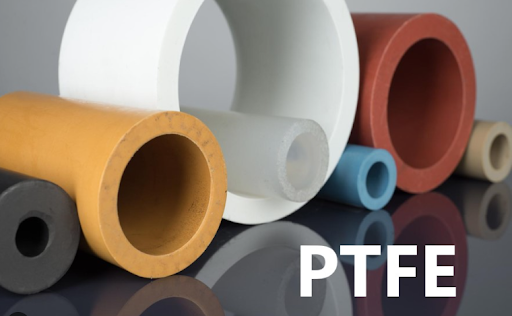
PTFE has very high chemical resistance
- Recyclability: PTFE plastic is known as one of the best thermoplastics, but when molded, it cannot be recycled.
- Safe for human health: PTFE plastic possesses a purity that is safe to come into contact with the user's food (some examples are PTFE made into cooking utensils).
- Durability: is considered an extremely durable material that provides users with long-term performance, can withstand and resist high stress levels, and has a low coefficient of friction.
- Chemical resistance: PTFE plastic has very high chemical resistance, like PEEK, PTFE plastic hardly reacts with chemicals.
- Temperature Resistance: PTFE exhibits excellent resistance to fluctuations in high and low temperatures.
Besides, PTFE plastic also has good resistance to UV radiation, oxidation, adhesion and water resistance.
5. Applications comparison: PEEK vs PTFE
5.1 Some common applications of PEEK:

Some of PEEK applications
- High pressure valve
- High vacuum factory
- Chemical and nuclear industry
- Oil well and geothermal applications
Manufacturers choose PEEK for the above applications thanks to its ability to withstand high pressure in harsh environments and its super durability.
5.2 Some popular application of PTFE:
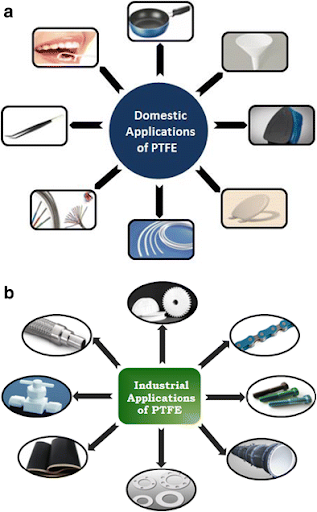
Some of PTFE applications
- Aerospace equipment
- Uses RF & microwave antennas
- Food processing equipment thanks to its non-stickiness and non-toxicity
- Petrochemical factory
-
High voltage applications
-
Valve seat
-
Corrosive chemical factory
-
Pharmaceutical factory
Thanks to its outstanding durability, PTFE is used in a variety of life applications and technical applications.
6. Conclusion
In general, in terms of the properties of PTFE vs PEEK, these two plastics both show superior properties compared to other plastics. Although they have similar properties, PTFE vs PEEK have quite different applications. Choosing the right material between PTFE vs PEEK for your product will help maximize product performance as well as optimize investment costs. Visit EuroPlas today to access a wealth of useful articles and data on choosing the right materials for your project!